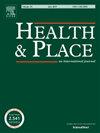Cooling down hotspots of retail tobacco products: addressing disparities in the built environment through policy
IF 4.1
2区 医学
Q1 PUBLIC, ENVIRONMENTAL & OCCUPATIONAL HEALTH
引用次数: 0
Abstract
Multiple disparities exist in the built environment for retail tobacco. Disproportionate concentrations of retail outlets result in variation in the availability of tobacco products, consumer access, and exposure to tobacco marketing. Neighborhoods with higher tobacco retail density have higher tobacco use than neighborhoods with lower density. Local policies focused on reducing tobacco retail concentration can address systematic disparities in the built environment.
Using census-based synthetic populations for 30 US cities and retail tobacco location data, we simulated the disparity-reducing potential of three retail reduction policies: capping the number of available retail tobacco sales licenses, and minimum distance requirements between schools and retail locations and between retail locations themselves. Outcomes included retail concentration in density (stores/km2) and proximity for residents (km to nearest retail). We investigated differences across seven demographic and structural indicators in the tobacco retail environment including social, economic, and political dimensions. All the measures for retail concentration and demographic and structural context have considerable variation within and between cities. All three policies addressed disproportionate concentrations to varying degrees. The minimum distance requirements – 600m buffers around schools or retail locations – narrowed differences in the built environment for tobacco more so than halving the number of existing retail outlets through licensing caps. Policy effectiveness is context dependent. Buffer policies, for example, can be effective if retail locations are disproportionately concentrated near schools, near one another, or in low-income or racially/ethnically minoritized neighborhoods. Policy development should be informed not only by generalizable evidence but also by local data and familiarity with communities.
为零售烟草制品的热点降温:通过政策解决建筑环境中的差异
烟草零售建筑环境存在多重差异。零售网点的过度集中导致烟草制品的可得性、消费者获取和接触烟草营销方面存在差异。烟草零售密度高的社区比密度低的社区有更高的烟草使用。注重降低烟草零售集中度的地方政策可以解决建筑环境中的系统性差异。使用基于人口普查的美国30个城市的合成人口和零售烟草位置数据,我们模拟了三种减少零售政策的减少差异潜力:限制可用零售烟草销售许可证的数量,以及学校与零售地点之间以及零售地点之间的最低距离要求。结果包括零售集中度的密度(商店/平方公里)和居民的邻近性(距离最近的零售商店公里)。我们调查了烟草零售环境中七个人口和结构指标的差异,包括社会、经济和政治维度。所有衡量零售集中度和人口结构背景的指标在城市内部和城市之间都有相当大的差异。这三项政策都在不同程度上解决了不成比例的集中度问题。最低距离要求——学校或零售场所周围600米的隔离带——缩小了烟草建筑环境的差异,通过限制许可,现有零售店的数量减少了一半以上。政策的有效性取决于具体情况。例如,如果零售店不成比例地集中在学校附近,彼此靠近,或者在低收入或种族/少数民族社区,缓冲政策可能会有效。政策制定不仅应以可概括的证据为依据,还应以当地数据和对社区的熟悉为依据。
本文章由计算机程序翻译,如有差异,请以英文原文为准。
求助全文
约1分钟内获得全文
求助全文
来源期刊

Health & Place
PUBLIC, ENVIRONMENTAL & OCCUPATIONAL HEALTH-
CiteScore
7.70
自引率
6.20%
发文量
176
审稿时长
29 days
期刊介绍:
he journal is an interdisciplinary journal dedicated to the study of all aspects of health and health care in which place or location matters.
 求助内容:
求助内容: 应助结果提醒方式:
应助结果提醒方式:


